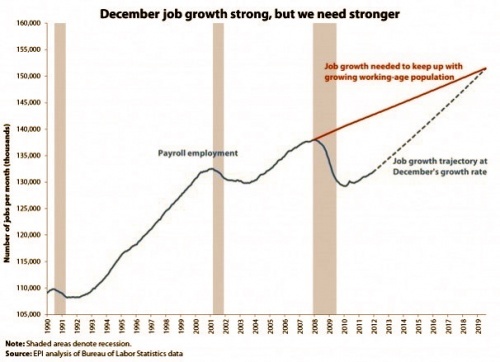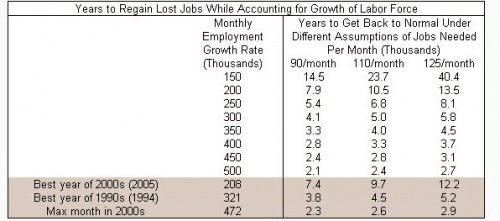

In manufacturing and services sectors as well as retail sales, US Fed “Beige Book Report” sees anecdotal evidence of improving US economy, except in housing. It is a stark indication of positive sentiment after much of end of last year. Employment though is lagging, as if to emphasize our article from yesterday: Read – “US Economy Better News But More for Entrepreneurs than Employees.” -
diplomaticallyincorrect.org/films/blog_post/us-economy-better-news-but-more-for-entrepreneurs-than-employees-by-ambassador-mo/43529
According to two more prominent economic analysis institutes, it will take 7 to 12 years for the labor market to recover to pre-recession levels. Based on December's report of 200,000 jobs created, the Hamilton Project predicted that the labor market would recover in 12 years. The Economic Policy Institute said it will take about seven years in a blog/article published in the Washington Post Wonkblog by Ezra Klein.
“Before the recession, the economy needed to produce 120,000 jobs a month just to keep up with new entrants into the labor market. Lately, that number has been closer to 90,000. Part of this is that immigration has fallen and many immigrants are leaving. Part of it is that some workers are leaving the labor force — either they can’t find a job and have given up, or they have decided to stay home with the kids or focus on other pursuits rather than take the sort of jobs they can get right now.
The question is whether the growth of the labor force bounces back or holds steady. And it turns out, this question matters a lot. This table that Greenstone (Bottom Chart) sent along shows how long it will take to reverse the jobs losses at different rates of payroll and employment growth. As you can see, if we’re adding 200,000 jobs a month, it will take almost twice as long to recover if we’re adding 125,000 workers a month rather than 90,000:” (Link to Article -
www.washingtonpost.com/blogs/ezra-klein/post/if-we-add-200000-jobs-a-month-will-recovery-take-7-years-or-12-years/2011/08/25/gIQA6AFtqP_blog.html?hpid=z14).
Mr. Klein’s own observation, if the unemployment rate drops gradually, based on the same level of job creation, it could in longer term be better news than quick drop in unemployment rate because it probably indicates a greater return of chronically unemployed/those that have given up – an increase in the labor participation rate from current levels of around 64% to more “normal” 66%. Of course, the question may be – is there a new normal based on self-employment, technology empowerment, demographics or all of above?
Regardless, the employment situation has probably been altered qualitatively as well as quantitatively. Benefits, salaries and job security are in an unfavorable transition for many traditional jobs/sectors. The delayed quantitative recovery in jobs created is only part of the ongoing divergence between economy and employment.
International Financial Crisis” Channel -
diplomaticallyincorrect.org/c/international-financial-crisis
By Ambassador Muhamed Sacirbey
Facebook Become a Fan at “Diplomatically Incorrect”
Twitter – Follow at DiplomaticallyX



